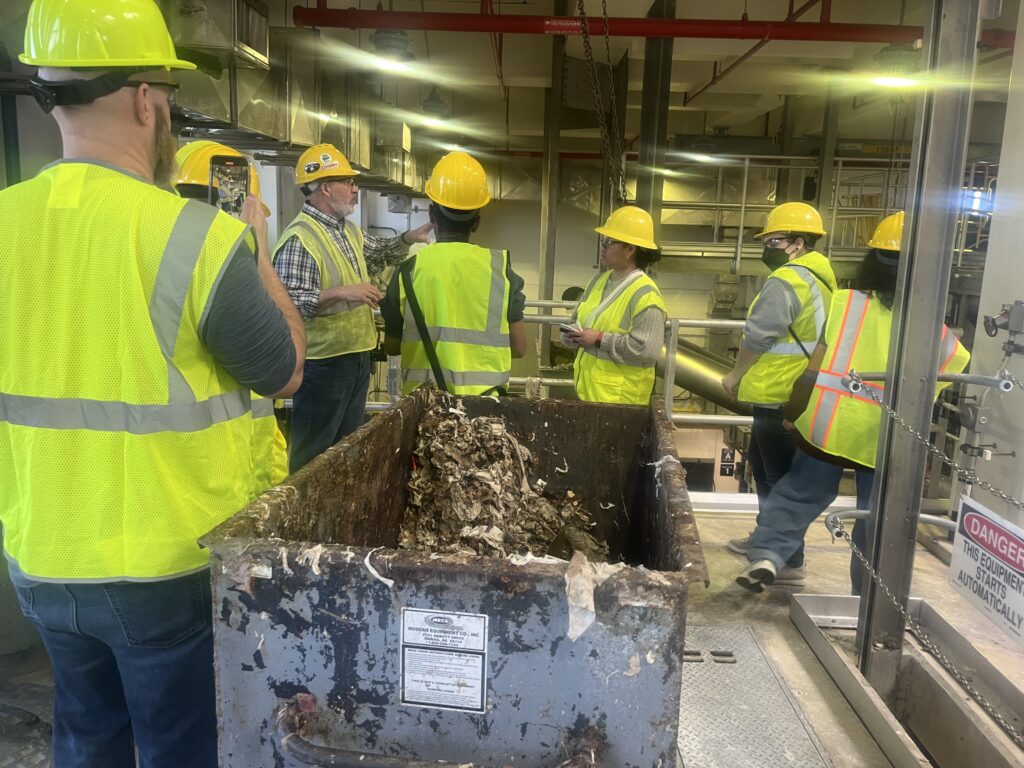By Desirae Sin
UConn Journalism
Hartford’s sewer system dates to the 1850s, when it was modeled on much older European waste treatment systems. In those early days, when fewer people lived in Hartford, waste channeled away from buildings, directly into streams and rivers, with the goal of keeping it away from contact with humans.
“It started here in the late 1800s and early 1900s, when people started recognizing there was a connection between wastewater, cholera, and dysentery,” said Tom Tyler, who showed journalists the operation of the Hartford Water Pollution Control Facility in the South Meadows area of the city.
Tyler is director of facilities for the the Metropolitan District Commission (MDC), which has managed water and wastewater in Hartford since 1929. The sewage treatment plant was built in 1938.
The MDC operates three other plants in East Hartford, Rocky Hill and Windsor. The Hartford WPCF is the only one that processes sludge, the solid material removed during treatment. Sludge from the other plants is trucked to Hartford, where it is incinerated to provide electricity for the plant.
On typical days with moderate weather, when the underground pipes can handle everything that goes into them, these pipes carry sewage from homes and buildings directly to the plant, where water is screened and filtered in several stages before being released into the Connecticut River.
The first stage is called preliminary treatment. Raw sewage flows through multiple moving racks, which screen out objects like toilet paper, solids, trash, condoms, tampon applicators, and more. This screening is not unlike giant combs or brushes moving through the water.
“We’re just trying to get big stuff out,” Tyler said of this first step. “This is a physical process. There’s no chemistry involved, no biology involved. All we’re trying to do is protect some big pumps” where water will filter later in the breakdown process.

“Wastewater treatment fundamentally comes down to one function. We take things out of the water that humans put into it. We give you perfectly clean drinking water, you make it dirty, and how we have to take out what you just put in it,” he said.
Next, the wastewater moves through aeration and settling tanks, where biological processes break down contaminants. Microorganisms in these tanks remove nitrogen from wastewater. This process does not remove all of the nitrogen, but it reduces the amount. High amounts of nitrogen can cause algae to build up and stimulate the growth of other aquatic plants.
“Nitrogen is like a fertilizer. If you put nitrogen on your lawn, it turns green,” Tyler said. “Everyone wants to bring on strong fertilizer. We want to remove that, because if nitrogen is in the river, it’s a fertilizer and it’ll grow plants. That in of itself isn’t so bad, except when those plants die, they need oxygen to decompose. They take oxygen out of the water. If we didn’t treat that wastewater, it’s going to immediately kill the fish.”
Secondary settling tanks aerate the wastewater next. As the water churns through these long tanks, it looks chocolate brown, but not from human waste; rather, this is from natural microorganisms.
In a later stage, the filtered water flows beneath ultraviolet lights, which disinfect the water before it’s released disinfection to the Connecticut River. Ultraviolet light treatment replaced past use of chlorine.
The electrical production facility at the Hartford WPCF uses the heat generated from burning the solids in wastewater to produce electricity. “It’s basically powering your own plant with energy created. It’s saved tens of millions of dollars, it’s very innovative,” said Nick Salemi, the MDC spokesperson.
“Part of the wastewater treatment process takes a lot of energy. The biggest cost of operating anything for the MDC is the electricity cost to operate the plant,” Salemi said, adding that the MDC is a non-profit company.
While the MDC operates the treatment facilities and controls the sewers, it is regulated by the Connecticut Department of Energy and Environmental Protection (DEEP), which is charged with enforcing the federal Clean Water Act for the U.S. Environmental Protection Agency (EPA).
Nisha Patel, director of the Water Planning and Management Division of DEEP’s Bureau of Water Protection and Land Reuse, said the department regulates how sewage is collected, how the plants filter and treat the water to proper standards, and “discharging it to a level that is consistent with our water quality standards.”
The standard of the Connecticut River, which takes on treated wastewater, is “SB,” which means it is surface water used for a mixture of uses, including recreation, commerce, and industry.
As in all of New England, conditions in Hartford include large amounts of wet weather. This phenomenon is exacerbated because of climate change and the extreme weather associated with it. The system was not designed to handle so much water.
Salemi emphasized that flooding happens during heavy rainfall. “Most days it’s fine. It’s a capacity issue for the pipes. The city was built before [the infrastructure] in Hartford,” he said. “The CSOs happen when it rains a lot. Even if you have regular steady rain, there’s still enough capacity.”
For the past few decades the MDC has been updating the centuries-old system, and that work will continue for up to a few decades more.
“You can’t dig up every street in Hartford at once and replace one pipe with two pipes. But you find the areas that are worse, so we strategically target areas,” Salemi said.
While sewer separation is still underway, the Hartford WPCF continues to operate and will continue operating. “We’re working 24/7. There has been a human at this facility since 1938 and there will be a human at this facility until the foreseeable future as long as there are people in the Greater Hartford region that need water,” Tyler said.
TOP IMAGE: The first stage of sewage treatment removes large objects, which end up in dumpsters. Photo by Elijah Polance
